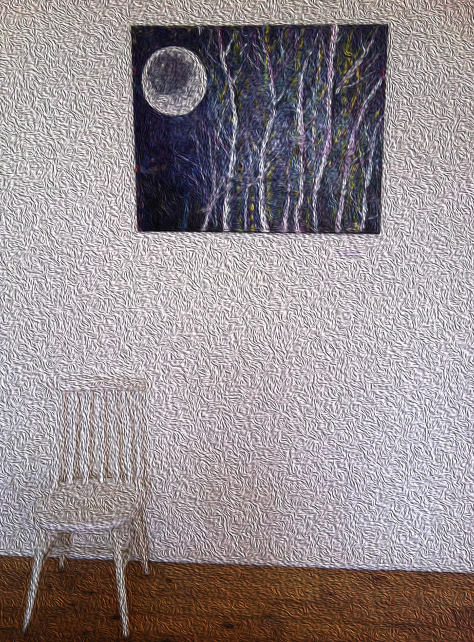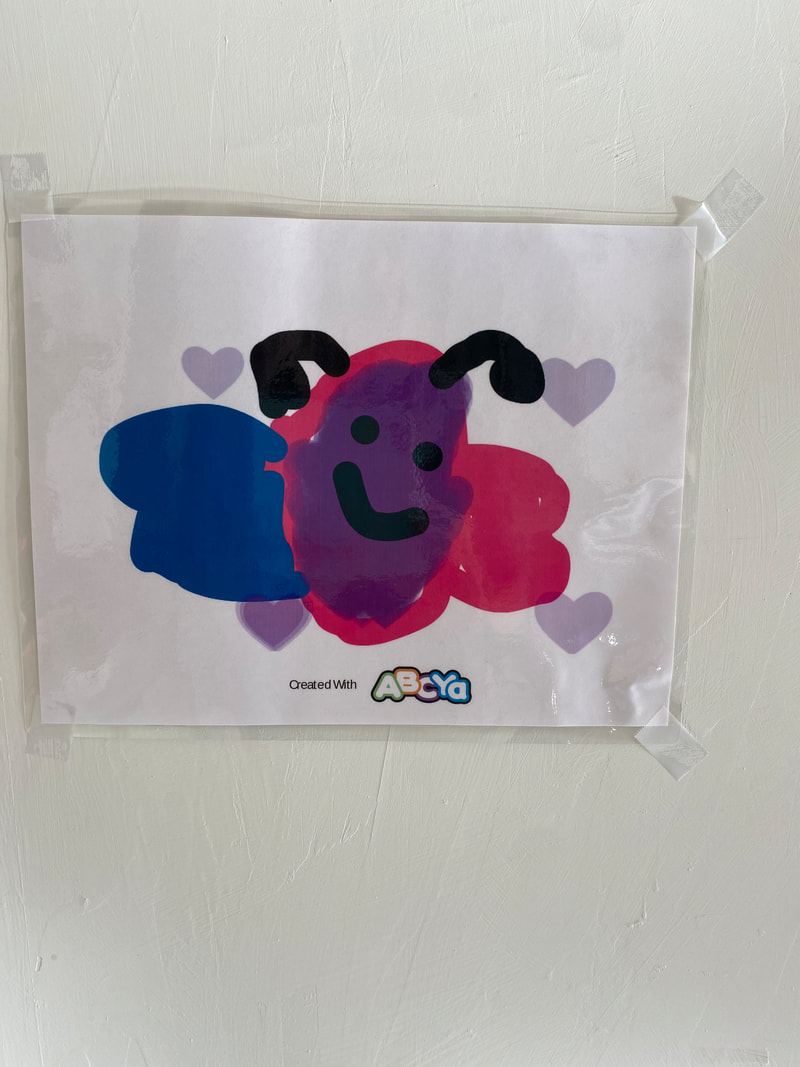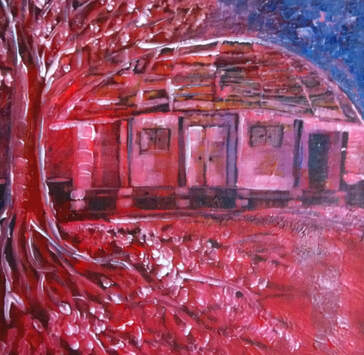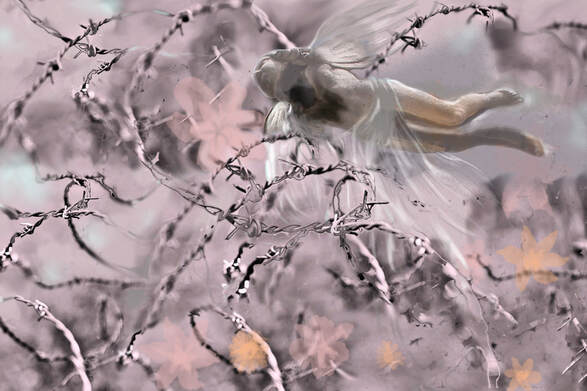Home is where the art is. COVID-19, which took the world as an unexpected sudden storm in 2020, is still hovering around us in various mutations and forms of regulation. Our patience begins to run out of limited gages after years of tension and the bondage of control and freedom. Sometimes this type of life of wearing a mask, washing hands thoroughly with disinfectant, getting vaccinated, isolating, and maintaining distance between people is accepted as a form of the new normal, and gradually you start to adapt. Whenever I read related articles or community posts, I find that people now complain about newly changed life patterns and styles of life after two years and enter three years. Due to restrictions and distance between people, only essential meetings and human relationships are left, so we experience a detox of social life. In the meantime, looking back on the past, we reflect on the fact that there were a lot of unnecessary meetings and social relationships. In a nutshell, we are leaving only minimal relationships and important gatherings, becoming a social minimalist, and organizing things one by one. Then, calmly stay at home, read a book, watch a movie, listen to music, and drink coffee. Exercise, work, education, and meetings all take place at home. The concept of the house is no longer a physical and architectural space but a shelter and healing space responsible for health and safety and rests the weary mind. For this reason, the value of homes and private rooms is increasing worldwide as we spend at home all day long, the purpose and definition of the house change. People who stay all day in these homes are increasing their demands for decorating their homes and changing the wall and spaces to fit their lifestyle. Now, painting is not just for interior decoration, but also it transforms into a medium that comforts people's hearts and delivers healing energy with various colors and themes in the space where most people are staying. In the past, there was a strong perception that painting was an adjunct to a form of culture enjoyed, purchased, and engaged only by a special class or people involved. Even when I was doing an exhibition, I sometimes found that visitors were getting a little nervous as they entered the gallery. Sometimes they ask, "Do I have to pay? When I see a painting, do I have to buy it by all means?" Every time I was asked such a question, I was depressed. I hope that all humanity can comfortably appreciate and rejoice in painting without any stress, be healed, comforted, and strengthened through art, understand the lives and values of others, and get an identity. Even though paintings have not even a virus, it's a pity how long paintings should be confined to museums or art galleries and should be quarantined in a word. The process of painting is like a mechanism of healing the inside. The painting was completed by drawing human wishes, hopes, feelings, philosophies. Because painting and life are inseparable from each other, people use the colors, codes, and perspectives that come out of the paintings to give them the effect of indirectly experiencing the world of another. Therefore, in the era of Corona, painting can be a valuable tool for self-healing with psychological colors that will calm and strengthen the consciousness and the unconscious for my family and me. Actually, among the posts I read with interest recently, there was an article about a group of painters working on a project under the theme of necumix for personal space of the Bible concept. ("The theme is "Four Cubits," relating to the biblical concept of personal space.") Rami Ogeri, founder and chief curator of the Jerusalem Biennale, acknowledges that the opening of its fifth Biennale has faced unique challenges, including budget and travel constraints. Nevertheless, he has gathered around 300 artists, mainly from Israel, but from the United States, United Kingdom, Italy, Belgium, Turkey, Greece, Morocco, United Arab Emirates, and Argentina. The theme is "four cubits," related to the biblical concept of personal space. "This year's Jerusalem Biennale is very different from previous biennials, where we gathered in museums, galleries, and other public places to share art experiences," said Ozeri. "This year, we ask the question whether art is part of our private realm. Do you have meaningful artwork on your living room, bedroom, or kitchen walls? So how do we go one step further and share this art with family, friends, or strangers?". Celina's works Ozeri shares that his children have a monthly rotating exhibition of their artwork in his own home. In my case, I also share a workspace with my child, who likes to paste his drawings here and there like me. Looking at her pure and fancy paintings, I feel like I am healed by itself. He concludes by introducing the works of the painters. In that spirit, if the corona lockdowns left you climbing the walls, now is a good time to refresh them with a painting. Even when life is not picture-perfect, it can incorporate a thing of beauty. As the Post's Barry Davis put it, "Home is where the art is." I agree with his opinion. Home is where art is. It is a space where you can touch and experience art up close and approach the world of pure action that art gives you without any restrictions. If you can heal your body and mind tired from Corona by hanging a picture that fits your code in this space, you will somewhat mature yourself and look into the future together in a healed state through inner healing. And we will have to keep pace with the changes in the post-corona era by checking the positive points of the social atmosphere that has changed in the post-corona period and making use of the good points. In that sense, the house will become an essential window and universal channel through which art and human beings become one.
2 Comments
Does a society for the weak exist?Last year, when the coronavirus was in full swing, everyone had to quarantine. First was a week, then two weeks, then a month. When a month came, I thought it would be enough, but two months have passed. It broke my expectations, and I had to stay at home for a few months. The tedious time passed with isolation. Moreover, there were videos of people suddenly falling to death on the street. We can hear many rumors about the origin, whether a bioweapon, an accident, or an intentional leak from a laboratory. Just as a child would be surprised to see the shadow swaying outside the window on a thundering day, so many people were locked up in the house for fear. It was indeed a time to be told when the whole world experienced the same traumatic memories. For a while, hopes for a vaccine, the dropdown of the cases, and people slowly began to take off their masks made everyone talk about last year as if it were a thing of the past. We went to shopping malls, had graduation ceremonies, had birthday parties, and spent everyday moments that everyone missed and realized how precious they were. However, now again, many types of mutations are being discovered worldwide, including delta mutations. When the coronavirus was first defined with a name and code, many experts predicted in deep concerns that this pandemic would take 2-3 years to get under control. I couldn't believe it when I first heard the statistics. In two or three years, it would be 2022 or 2023, but again, the time has to pass. But, as always, the experts are right. We're stuck with the virus again. But what is even more surprising is that the virus, which I had only heard the news about that personally, but when I experience closely came in close contact, I was shocked that there are many holes in the control and management. That so it was not well controlled as well as we wished. How can we prevent an invisible virus entirely? It isn't anyone's fault that becomes the case. But as I am raising children, I hear these and other related stories. Children, in particular, do not get even the vaccine that is called the only best treatment until now. They are socially underprivileged. Parents raising children like this want our community to do the best it can. They want a safer society, take their children, and raise them safely and happily. That is how we have a future. I thought what is Justice. Does Justice for children really exist? In particular, the Justice that should be given to the weak is judged by adults from the perspective of adults. No one ever apologizes to the weak such as children. Yes, the strong know that there is no need to apologize. They are clever. They only think according to their interests. According to the claims, excuses follow. Meanwhile, the weak are increasingly marginalized and suffer. Just because they can't say and are weak. the child is so ignored. Most regulations are also made to protect the benefits of the strong. The weak will not be able to claim it anyway, so they talk more complicatedly and cleverly. Regulations are therefore necessary for them. They always say that "We are following the rules." No words to say sorry. They just need to think about their position and reputation when problems arise. And know Doing so, as always, allows them to defend their interests further and become stronger. I remember doing an online exhibition in Port Washington on the subject of Justice in the past. This painting was posted painting at the time. When I went to the Duomo in Italy, I have looked up at a statue in the shape of an angel embedded in a pillar. Of course, the sculptor who sculpted the statue probably didn't put him on the stone pole but just sculpted his upper body and put it on the bar. But at the time, it seemed to me that he was stuck on a pole and could not fly because the sky is so beautiful and blue. There is an angel named Justice. He also wants to fly according to the wishes of many people. And everyone wants to see the angel. How wonderful it would be to see angels flying in the beautiful sky. But the angel can't go any further, trapped in the many prejudices created by people who want Justice but indeed don't really want it. He has no arms, so he can't remove the twisted wire from which he is trapped. The angel has no arms because he cut them himself off. He removed his arms because doesn't want to lean right or left. But instead, his righteous heart prevents him from clearing the obstacles in front of him. Just because it's good doesn't ironically fight more evil.
Anyone can make mistakes. We all know how erroneous mistakes we can create in life. If everyone is crying out for Justice and judging and attacking each other, it is also not an ideal society. But at least in the community we live in, I want the weak to be protected by the word of Justice so that they can be kept safe from the mistakes of the strong. An white table painting Edward Hopper (1882-1967) was an American realist painter and printmaker. He mainly painted the daily lives of marginalized people in big cities where everyone is lonely. On October 24, 1929, the New York stock market crashed. In short, it was the beginning of that historic economic great devastation. Prosperous companies went bankrupt, the unemployed filled the streets, and there was the worst deflation. In the 1920s, the era of success when anyone had hope and achieved something was over. Literally everyone went broke. Edward Hopper quietly captured the lives of urbanites living in loneliness and weary life during the economic hardships of the 1930s on a canvas. In his paintings, there was no corona at that time, but everyone is keeping a 6-feet distance. Their distance seems to show the loneliness of city dwellers who don't want to be close anymore but stay by their side out of necessity. The people in his paintings did not make eye contact and look at a sense of melancholy or isolation. When we are in trouble or feel sad and depressed, we want to go into our own quiet space and calm our minds. So when I see Edward Hopper's paintings, I always think of the energy of space. It was the same with the 6-feet area I experienced during the pandemic and the room that Hopper drew 90 years ago. All the blanks give the fear that the empty will never fill it. It feels like an indelible time fixed on the canvas, like the distance of a hopper in a painting. I want to invite people who are suffering from being trapped in this space. Of course, it is not a physical space, but a space in the picture. So I placed a white chair close enough for a few people to sit and make eye contact. And put a white round table in the middle. Then, in order to avoid finding a place to sit, I set the composition slightly to the right and pull the chair slightly on the left. So sit here in this chair! And I put red flowers in the center of the table. I hope that the bright light from the pretty lamp pouring from above will brightly comfort our hearts. After overcoming all difficulties since last year, I looked around and saw the heroes who fought for us. My daughter's friend mother is a nurse, and she fought fiercely at the forefront of the war called Corona last year. She sincerely cared for sick corona patients. But, when the patient died suddenly, she said that she was sad as if her heart were torn. So she couldn't go home right away to calm her sad heart, but instead got into the car and drove down the road until she calmed down. How would we live without these angels like her. I gave her a picture in the hope that even for a moment that sad heart could rest in this little picture. I am so sorry that the only thing I can give to the heroes who risked their lives for us is a piece of paper. Could there be a scene next time sitting at this round table and laughing and chatting? Thanks to our heroes, we are already living that way. Art in a pandemicNowadays, the weather is excellent, so I often come to the yard to see the crystal clear blue sky. If I remember, around this time of last year, the sky was as clear and bright without any impurities as today. Simultaneously, the picture-like-sky seen by us, isolated as a pandemic, was another form of comfort. So I took a picture like this to keep the message of hope. Now, people are getting vaccinated in earnest, and finally, cases are decreasing. The vaccination rate is 52.2% in our county, and the positive test rate is 1.4 %, and the vulnerability level is medium. So now, people are cautiously talking about hope for the future.  When I first heard the news that we had to shut down due to the Covid virus, I went to Costco to be sure to maintain at least a 30-day supply. But as you all know, the toilet paper was sold out, and there was no way to get eggs and bread. Later found out that it was really only trivial. By the way, for a long time, I couldn't even take a step outside the house, so I was trapped inside the house and only listening to news about viruses, hospitals, coffins, and graveyards every day. Back then, my 3-year-old daughter made play-dohs and put them on her play pink table like below, and no one could touch them. It seemed like it was a kind of ritual to fight awful stress. Eventually, it had become a daily routine to see the coffins or bodies on the news. But, the thing that hurt me the most was when I had heard a plan to use an ice rink in the neighborhood to store body. It was a horrible nightmare, although the idea later changed to use the farm's old freezer. In Spring 2020, we felt unfamiliar when seeing and hearing the beautiful sky, fantastic weather, and pretty bird sounds. We became prisoners of fear for almost a month and did not even go to our backyard. Then, by the time we accepted the sad routine as part of us, we could go outside. Worried that there would be a virus in the cool breeze, we came out cautiously, but my daughter ran to the bottom of the tree like a spring in a machine. She danced, watching the beautiful singing bird on the branch. Also, I have a similar experience when I took her for the first time to the school last September. Everyone was standing at the school's door to send the children to school, wearing masks and carefully holding them 6 feet. At that moment, everyone is tired of long isolation life, and no one dared to speak. Just then, a little boy looked up at the sky and shouted out. "Mom, look at that! It's a moon." Children are excited when they see the moon appear white in the morning. Only then that people began to relax and laugh. From my perspective, the sound of children's songs and laughter in difficulty and hardships, like candlelight coming out of darkness, are messages of hope that we must keep. And it is art itself. In the past, during the Spanish flu, our senior painters drew a picture with such a childlike mind fighting fear. In New York Times Style Magazine, I can discover in the meaningful related article, "What Can We Learn From the Art of Pandemics Past?" " We will all have our own metaphors and images to make meaning of this time: art or reportage or our own witnessing, the visuals that endure, reflecting us back to ourselves." (By Megan O’Grady). Slowly running in a dark tunnel towards the light, we all became witnesses and companions to share the testimony out of grid life. "The 2020 pandemic will change the way we see art forever, too, and artists and writers have already begun doing the work of illuminating new shifts and losses, documenting the small kindnesses and cruelties, the large failures of leadership, technology and society." (cited part of the reference article content) Above all else, I will try to leave something like a picture of last year's blue sky, like the play diagram my child has accumulated on her desk. It is a privilege of art to be able to look back on what remains so that even if it remains like any interesting event. Reference: https://www.nytimes.com/2020/04/08/t-magazine/art-coronavirus.html |
Myungja Anna KohArtist Categories
All
Archives
July 2024
|
Proudly powered by Weebly




















 RSS Feed
RSS Feed